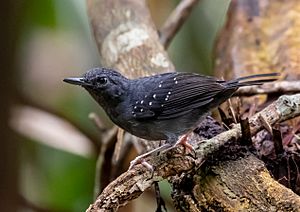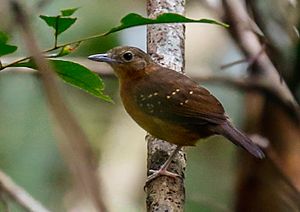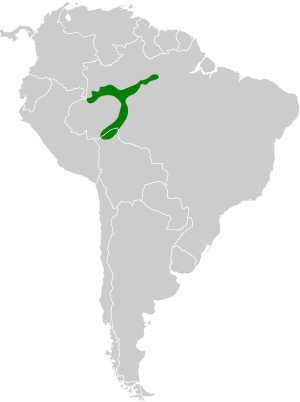Humaita antbird facts for kids
Quick facts for kids Humaita antbird |
|
|---|---|
 |
|
| male at Careiro, Amazonas state, Brazil | |
 |
|
| female at Careiro, Amazonas state, Brazil | |
| Conservation status | |
| Scientific classification | |
| Genus: |
Myrmelastes
|
| Species: |
humaythae
|
 |
|
| Synonyms | |
|
|
The Humaita antbird (Myrmelastes humaythae) is a fascinating bird that lives in the warm, wet forests of the Amazon rainforest. It's a type of passerine bird, which means it's a "perching bird" – like most songbirds you might know. This bird belongs to the Thamnophilidae family, often called "antbirds" because some of them follow ant swarms to find food. You can find the Humaita antbird in southwestern Brazil and Bolivia.
Contents
Where the Humaita Antbird Lives
The Humaita antbird makes its home in the humid forests of the Amazon. This means it prefers places with lots of rain and thick trees. Its main territory is in the southwestern part of the Amazon, especially in parts of Brazil and Bolivia. These areas are rich in plant and animal life, providing the perfect environment for this bird to thrive.
How Scientists Discovered It
For a long time, the Humaita antbird was thought to be just a type of subspecies of another bird called the spot-winged antbird. A subspecies is like a special group within a species that has small differences, often because they live in different places.
However, in 2007, scientists did a special study. They listened very carefully to the vocal characteristics (the sounds and songs) of the Humaita antbird. They found that its calls were quite different from the spot-winged antbird. Based on these sound differences, they decided that the Humaita antbird was unique enough to be its own separate species!
Today, the Humaita antbird is considered monotypic. This means it's the only type of Humaita antbird species; there are no other subspecies within it.
Its Conservation Status
Scientists and conservation groups keep an eye on how many of each animal species are left in the wild. This is called their conservation status. For the Humaita antbird, its status has been checked by an organization called BirdLife International.
They have assessed the Humaita antbird as being of Least Concern. This is good news! It means that, for now, there are enough Humaita antbirds in the wild, and they are not considered to be in danger of disappearing.
See also
 In Spanish: Hormiguero de Humaitá para niños
In Spanish: Hormiguero de Humaitá para niños


